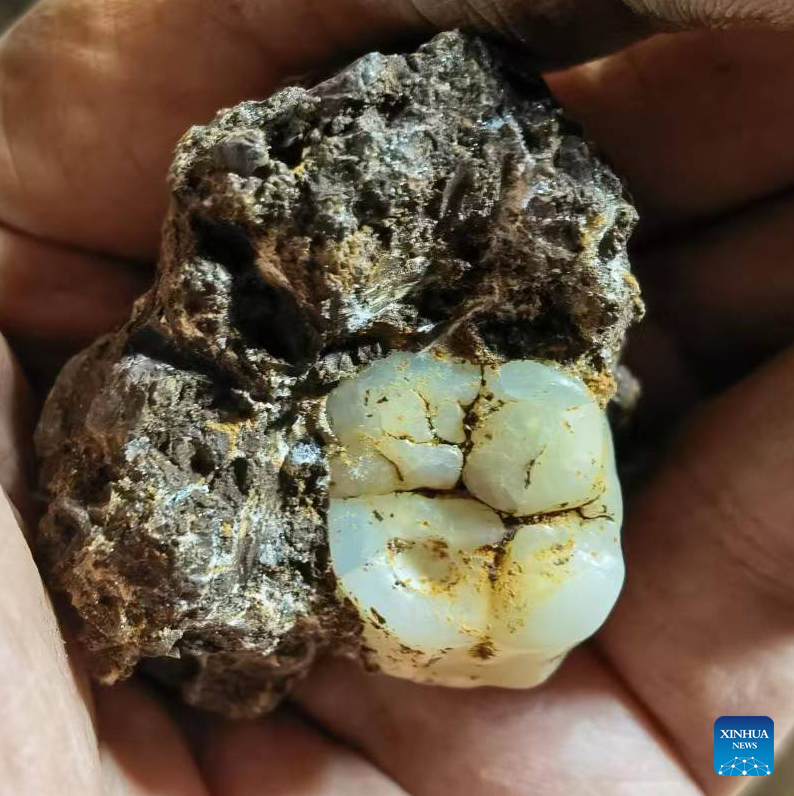Researchers reveal mystery behind giant ape extinction
From:XinhuaAuthor: 2024-01-11 15:17

This undated file photo shows a fossilized tooth of the giant ape, Gigantopithecus blacki, excavated by scientists in south China's Guangxi Zhuang Autonomous Region. An international team of scientists from China, Australia and the United States unraveled the mystery of when and how the largest ape ever known on Earth went extinct.
An international team of scientists from China, Australia and the United States unraveled the mystery of when and how the largest ape ever known on Earth went extinct.
The Gigantopithecus blacki, or G. blacki, a three-meter-tall primate weighing up to 300 kilograms, once roaming the Karst plains of southern China, died out at some point between 295,000 to 215,000 years ago, earlier than modern human's arrival in this region, according to the study published on Thursday in the journal Nature.
The find debunked the myth in some popular tales that the massive ape, in close kinship with orangutans, was ever spotted in forests by human beings.
TEETH FOSSILS
G. blacki was named by paleoanthropologist Ralph von Koenigswald in 1935 based on one molar tooth measuring about two centimeters in length. The "blacki" was given in honor of the Canadian anatomist Davidson Black, who had investigated human evolution in China.
Since the 1950s, around 2,000 fossilized teeth and four jawbones of the giant ape have been excavated in south China's Guangxi Zhuang Autonomous Region. But nothing from the neck down or from the jaw up has ever been found until now.
"The story of G. blacki is an enigma in paleoanthropology," said the paper's co-lead author, Zhang Yingqi, from the Institute of Vertebrate Palaeontology and Palaeoanthropology (IVPP) under the Chinese Academy of Sciences. "The unresolved cause of its disappearance has become the Holy Grail in this field."
In 2015, Zhang and his colleagues launched a massive investigation in which they conducted a blanket search among hills across Guangxi. They collected evidence from 22 cave sites -- half containing G. blacki remains and another 11 of a similar age range where no G. blacki evidence was found.
In the follow-up work, the team used six different dating techniques for the cave sediments and fossils. The 157 dating results revealed this species was on the brink of extinction between 295,000 and 215,000 years ago.
A primary dating technique used in the study measured the light-sensitive signals found in the burial sediments encasing the fossils.
The ages from these were consistent with direct dating results on fossils. Together with the results of other techniques, they built a comprehensive and reliable chronology for the extinction of G. blacki.
"Establishing the exact time when a species disappears from the fossil record gives us a target timeframe for an environmental reconstruction and behavior assessment," said the paper's co-lead author, Kira Westaway, from Macquarie University in Australia.
VULNERABILITY
With further evidence from pollen, fauna and stable isotopes, the team reconstructed the history of the ape's extinction.
The giant flourished in thick forests between 2.3 million and 700,000 years ago, but in the subsequent 400,000 years, the environments turned more seasonal, so their preferred habitats became sparse with the non-woody plants expanding, which heralded G. blacki's demise.
Against such survival stress, orangutans adapted their size, behavior and habitat preferences. But how could such a mighty creature fail at a time when other primates scraped a living?
The team analyzed the trace elements and dental micro-wear texture in the teeth of G. blacki and orangutans. "Teeth provide a staggering insight into the behavior of the species indicating stress, diversity of food sources, and repeated behaviors," said Renaud Joannes-Boyau from Southern Cross University in Australia, also the paper's co-led author.
The result revealed that G. blacki relied on less nutritious, high-fiber backup food when its preferences, like fruits and flowers, were hard to find, thus lowering the food diversity.
However, those picky eaters had a reduced foraging range, and thus dwindled in their populations. In comparison, dental analysis showed more agile adapters like orangutans managed to seek out more food sources and establish new ecological niches, said Zhang in a press conference on Wednesday.
Also, G. blacki became bigger during evolution for still unclear reasons, thus worsening the chronic stress of food shortage, Zhang added.
"Exploring the reasons for past unresolved extinctions gives us a good starting point to understand primate resilience and the fate of other large animals, in the past and future," said Westaway.
Edit:董麗娜
The copyright of the article and the picture belongs to the original author. If there is any infringement, please contact to delete it